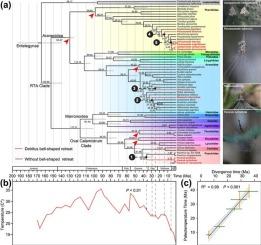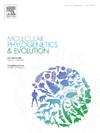蜘蛛巢的起源、多样化和建筑的可塑性与历史和当前的温度波动有关。
IF 3.6
1区 生物学
Q2 BIOCHEMISTRY & MOLECULAR BIOLOGY
引用次数: 0
摘要
持续的气候变化要求提高对温度波动如何影响生物体进化和行为的理解。蜘蛛以碎石为基础的巢巢在同一时期多次出现,这被假设为对气候波动的适应性反应。在地质时间尺度上,研究了气候变化对坎帕尼科拉(Campanicola campanulata)巢退演化的潜在影响,以及温度对坎帕尼科拉(Campanicola campanulata)巢退形态和能量投入的短期影响。系统发育分析重建了12个巢退的起源,最早出现在始新世,并在晚新生代冰窖时期多样化。蜘蛛对实验中降低的温度做出反应,会做出更大的巢穴撤退,这表明温度对撤退结构有直接影响。我们的研究结果首次证实了蜘蛛巢穴的温度调节功能,并表明温度在进化和生态的时间尺度上影响着巢穴的撤退。迁巢蜘蛛可以作为研究动物体温调节造巢的起源以及它如何受到持续气候变化的影响的模型。本文章由计算机程序翻译,如有差异,请以英文原文为准。

Spider nest-retreat origin, diversification, and architectural plasticity link to historical and current temperature fluctuations
Ongoing climate change mandates improved understanding of how temperature fluctuations influence organismal evolution and behavior. Detritus-based nest-retreats in spiders have originated multiple times in parallel—hypothesized to be an adaptive response to climatic fluctuations. We investigated the potential role of climate change in shaping the evolution of nest-retreats over geological timescales, and the short-term effect of temperature on the morphology and energy investment of nest-retreats in Campanicola campanulata (Theridiidae). Phylogenetic analyses reconstruct twelve origins of nest-retreats, first appearing in the Eocene, and diversifying during the Late Cenozoic Icehouse period. Spiders respond to experimentally lowered temperatures by making larger nest-retreats, indicating a direct impact of temperature on retreat architecture. Our results for the first time affirm the thermoregulatory function of spider nests and suggest that temperature impacts nest-retreats across both evolutionary and ecological timescales. Nest-retreat spiders can serve as a model to study the origins of thermoregulatory nest-building in animals and how it may be impacted by ongoing climate change.
求助全文
通过发布文献求助,成功后即可免费获取论文全文。
去求助
来源期刊
CiteScore
7.50
自引率
7.30%
发文量
249
审稿时长
7.5 months
期刊介绍:
Molecular Phylogenetics and Evolution is dedicated to bringing Darwin''s dream within grasp - to "have fairly true genealogical trees of each great kingdom of Nature." The journal provides a forum for molecular studies that advance our understanding of phylogeny and evolution, further the development of phylogenetically more accurate taxonomic classifications, and ultimately bring a unified classification for all the ramifying lines of life. Phylogeographic studies will be considered for publication if they offer EXCEPTIONAL theoretical or empirical advances.

 求助内容:
求助内容: 应助结果提醒方式:
应助结果提醒方式:


